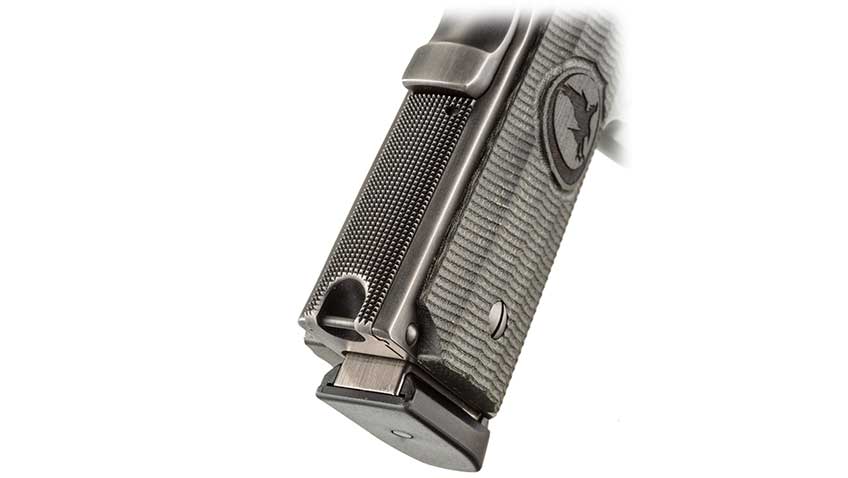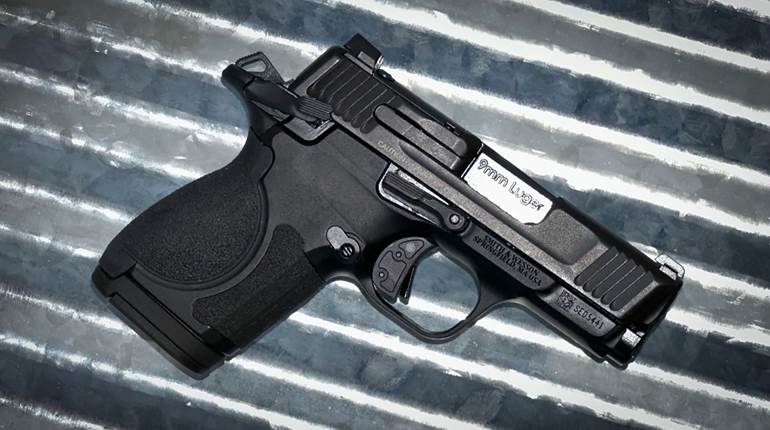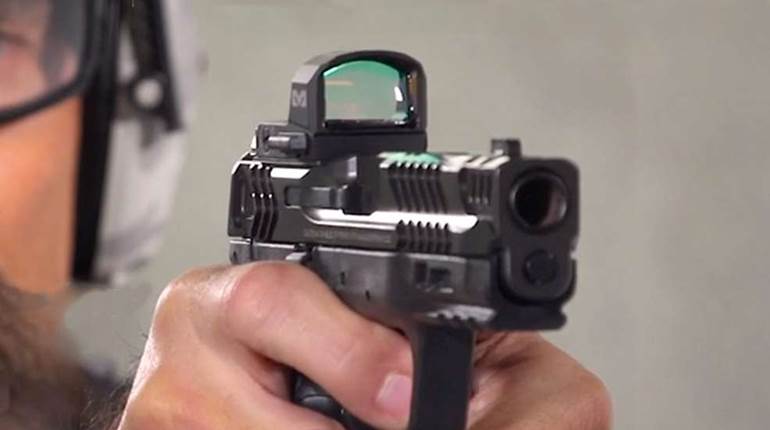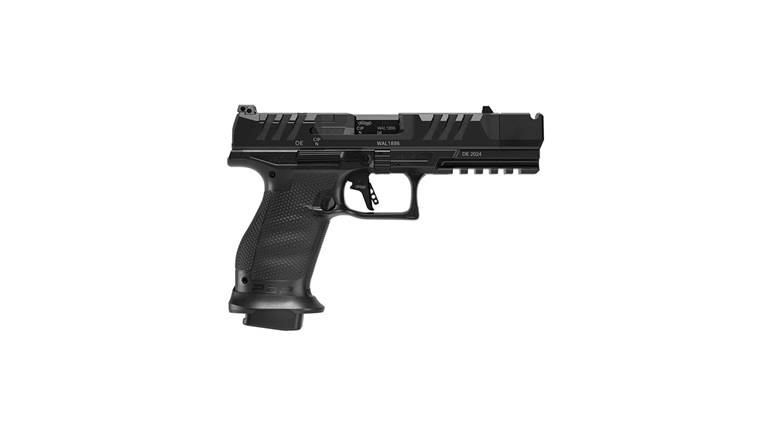
From my position at the end of the firing line I went into action, left hand to center line of my torso, right hand to the pistol’s grip. Drawing the gun upward, as soon as the muzzle cleared leather I rotated it to the target. My hands came together and pressed the pistol forward in a controlled motion until the gold bead front sight came into my plane of vision centered on the target—just where I knew it would be.
Two rounds in rapid succession followed, not because I was trying to shoot fast, but because the smooth cycle of the slide and barely perceptible rise of the muzzle presented me a clean second sight picture without any additional effort or input. As I held the pistol on target awaiting the next command, I heard to my right the unmistakable growl and gravel of Clint Smith’s voice ring out over the din.
“Load the gun Mark! Don’t be gentle, load the f—ing thing.”
Since my cardboard assailant had been well perforated and wasn’t likely to go anywhere, I risked a glance over my shoulder to see Smith standing behind Mark Stone—owner and founder of Nighthawk Custom—with his hands like blinders covering Stone’s eyes.
“Don’t look for the magazine, you know where it is. Grab it and put it in the gun.”

Despite the added stress of receiving Smith’s famous brand of special attention, Stone responded by grasping a full magazine from his belt pouch, bringing it up to the gun—bullets forward, controlling the top round with his index finger—and driving it home into the magazine well. “Don’t be nice to it, rip the slide off,” Smith bellowed. Racking the slide to the rear, Stone oriented the freshly loaded pistol, gave the target two more shots for good measure and continued to hold the gun at the ready.
“Good job, Mark. Now, just do that 6,000 more times and I think you’ll have it.”
As we took a break to drink some water and load magazines, Stone turned to me with about the biggest smile I’d ever seen, and in his charming Arkansas drawl managed, “Man, isn’t this the coolest.” It definitely was.
It was a bit of a whirlwind that brought me, Mark Stone and Nelson Davis, Nighthawk’s chief operating officer, to the hills of south-central Oregon and to the vaunted ranges of Thunder Ranch, but the location could not have been more auspicious. The ranch complex is idyllic, tucked into the mountains and occupying a valley that itself stands around 5,400 ft. above sea level. Access is granted by a gated and covered bridge, and a gravel road winds among the evergreen trees and a couple of small creeks.
It made for a truly beautiful setting, and I tried my best to soak it in while also remaining focused on the task at hand. I’d come to Thunder Ranch as a guest of Smith and Stone to see firsthand the forging of a new alliance, and the result of a combined endeavor—the Nighthawk Custom Thunder Ranch edition pistol, dubbed the Combat Special.

“I always say talk is cheap, anybody can say something. But when they write it down or put their name on it, that’s a whole new level of ownership."—Mark Stone, Nighthawk Custom
In the case of the Combat Special, both the craftsmen of Nighthawk Custom and the defensive experts of Thunder Ranch have staked their name, and their reputation, indelibly onto a gun. A recoil-operated semi-automatic pistol, chambered in either .45 ACP or 9 mm Luger, the Combat Special is a blending of Smith’s old-school grit with the old-world craftsmanship and modern, fully machined components for which Nighthawk is known.
Normally, I’d happily carry out the charge of bringing American Rifleman readers a thorough description of this very cool collaboration. However, being onsite at Thunder Ranch afforded me the rare opportunity to hand over that duty to a man who is uniquely qualified. What follows is Clint Smith’s take on the Nighthawk Custom/Thunder Ranch Combat Special, in his own words.
“The M1911 is a marvelous design to start with, and, not being ugly, we’re not really being innovative. This, in my mind’s eye, is a pistol that was designed for personal defense. That’s the goal. Yes, you can use it for sport shooting, and enjoyment, and plinking and all that stuff. But I want this to be a gun that I can pick up and use to defend myself.

“One thing I wanted was for the gun to be able to be taken apart by hand, with exception of the stock screws. I wanted the bushing to be able to come out by hand without a wrench. I do not believe that the gun needs to be overly tight in order to achieve the accuracy I want for personal defense. Now, if I want to go to Camp Perry and shoot bullseye, then I maybe want a different kind a gun. But a gun that I’m going to carry and fight with, well, I don’t want a World War I M1911, where you shake it and all the parts fall off, but there’s no reason for the gun to be overly tight in my opinion.”
Nighthawk managed to meet Smith’s requirement in this regard, and I can report that the gun does not possess the negative characteristics sometimes associated with new custom pistols, particularly the exceedingly tight slide that is hard to cycle and impossible to disassemble. That’s not to say the gun is loose, in fact there is no play at all in the slide-to-frame fit, but the slide glides smoothly and easily on the rails, and the bushing can be manually removed.
“Looking at the sights, they’re simple. We used the gold dot, and I like the gold because in a lot of environments it still gathers some degree of light. I personally believe the front sight, in a fight, has the potential to be under duress: Low-light, altered-light, moving targets, heart rate is up, etc. So, I wanted gold because it brings a little bit more gravity to the eye. We could paint it bright fluorescent orange, but that wasn’t a requirement, the gold serves the purpose for me, and it still has a degree of being pleasant aesthetically.

“[The Combat Special] uses a Heinie rear sight. No qualms with me about that at all. I really like the double set screws because I’ve seen a lot of rear sights come loose—it should be driven in and it should be solid, I don’t want the sight moving around. It’s a fighting pistol and I’m 70 years old, if I’m in a fight, I’m probably going to be on the ground. If I’m on the ground, banging around, and I get the gun out, I need for everything to be where it’s supposed to be.
“In terms of scalloping for cocking serrations or systems-check serrations, I don’t need anything real dynamic. I didn’t need it to look like a checkerboard up front, but I also didn’t want it to be smooth. I just need enough to be able to touch it, check it, see it, feel it. There are two [cocking serrations] up front and four in the back, and they’re nice because the angle matches the grip angle. It’s aesthetic, but they’re also done correctly.”
The serrations are relatively wide and deep, making it very easy to achieve a firm grasp fore or aft with bare hands or gloves.

“The one thing that [Nighthawk] did make for me that was a little bit off the chart was the safety. It’s different for them in that it is, for lack of a better word, a nub. I don’t really like the great big shelf-style [extended safeties], so the nub safety is cool.
“There is a slight extension on the slide lock, and I like the fact that it’s smooth. I don’t need it to be serrated. I’m not a big proponent of using the slide lock [on a reload], I work the slide, but I get it, it’s cool.
“The gun has the extended grip safety, and that’s appropriate. For me, personally, it’s a good deal because I’ve always gripped 1911s very high, and the bump improves engagement.
“The bobbed hammer is like a commander hammer, or a skeleton hammer. It’s a pretty consistent thing in the industry, so why re-invent the wheel? With the older style, the spurs cut a lot of people when they came back, or pinched their hands during recoil. The design idiosyncrasies need to make it a tool that I can touch and use without being cut to pieces.”

Handling an empty gun during our interview, Smith was eager to note the overall smooth finish of the Combat Special. “Anybody who ever shot one of the old Swensons [customized 1911s] knows, with no disrespect, that when you run your hands over them, it was like running a hand through a box of razor blades. That was before ‘melting’ the edges and corners—and I guess before the advent of the Dremel tool. [The Combat Special] is relatively smooth, it’s a hand tool—if I run my hand back and forth, I shouldn’t be bleeding.”
According to Smith, nor should you be able to inadvertently press out the gun’s takedown pin—and who would disagree? On that component, “I did ask Nighthawk to take the button off on the right side. On occasion, I’ve been on the range and pressed the pin out.” It is located just above the trigger guard, where one would likely rest their trigger finger. “Here’s a thought, if I can do it, I know that someone else can too, like, let’s say, a private in the Army or the Marine Corps—guys who can screw up a steel bowling ball, I should know, I was one of them. So let’s pre-empt that possibility. It does nothing to affect the gun in a negative manner when it comes to disassembly.”
Not only did Nighthawk remove the button, the frame is also relieved around the shortened pin to ease disassembly—but only when the gun is intentionally being taken down.
Moving on to the grip, “I like a flat mainspring housing. [The checkering] is 25 lines per inch, so it has some degree of texturing, but I don’t think it needs to be a set of raptor teeth either. It’s just functional. Frontstrap checkering is nicely done, it matches the back. Everything is straight— that’s a concept! It’s not all jarred up.

“And the lanyard ring [at the base of the mainspring housing] I’m really big on, I think if it’s a big enough fight, and you roll around in the dirt long enough there’s a possibility of losing the gun. I don’t wear a lanyard on a daily basis, but in some environments, I do snap a lanyard on. Like in winter here, I’ll put on a heavy jacket and a chest rig when I’m outdoors, and we have the potential out here to encounter a bear or a lion—I don’t want to be separated from the gun. There might be a little bit of nostalgia in it, but I think having the ability to anchor the gun to you is a good thing.”
Looking at the magazine well, “It has a reasonable taper, I don’t need a flare, I don’t want a flare—I don’t like all the extra stuff, and [the flared magazine wells] pre-empt the use of standard magazines in some cases.”
The Combat Special wears Micarta stocks, engraved with the Nighthawk Custom logo and relieved to ease access to the magazine release. “The stocks are textured, they’re green, it’s a handsome color. And I kind of like the green because [at Thunder Ranch] in Texas, our staff shirts were red. When we came to Oregon, our primary color became green. The green is cool. I also like that they have slotted screws. I don’t want to run around looking for an Allen wrench—you can have a hundred of them, and none of them will be the one you want.

“I’m not a trigger measurer, I don’t know the weight Nighthawk used, but it’s the trigger I want—it goes when I want it to. I don’t need a hair trigger, but I don’t need someone having to tweak it, either.” Ten pulls with a Lyman digital scale confirmed the test sample’s trigger pull weight was a very consistent 4 lbs., even. The trigger is a curved, mid-length unit with vertical serrations adding texture to the face.
Taking in the overall appearance of the pistol, “The finish I like, I would call it a ‘used’ look. I like it because this finish is going to wear really well. It’s only going to look better because of this smoke-like distressed finish.” Adding to the aesthetic appeal, of course, is the Thunder Ranch emblem engraved behind the rear cocking serrations on both sides of the slide.
Coming full circle, Smith reiterated that the Combat Special, at its heart, is the tried-and-true 1911 platform. “Standard trigger guard, standard magazine release. If we took an original 1911 or a 1911A1 the day it came out of the factory, and we laid this gun beside it, there wouldn’t be that much of a difference. ‘Oh, those sights are a little bigger.’ Well, from the 1911 to the A1, they put a little bit bigger sights on them. They were still sh-t, but they were better than the first ones which were basically no sights at all. But if we laid this gun down, John Browning’s gun is right here, made today. Unquestionably a 1911.”
“All I’m trying to do is teach people to win and stay alive.” —Clint Smith, Thunder Ranch

Luckily, while we were at Thunder Ranch we not only talked about the guns, we also got to shoot them, including Combat Special Serial No. TRN0001 in .45 ACP, which was presented to Smith during our visit by Stone and Davis to commemorate the start of the new endeavor. On the line we had both Clint’s .45 ACP model, as well as Heidi Smith’s pistol, a prototype of the Combat Special chambered in 9 mm Luger. The real boss behind the Thunder Ranch operation and a virtuoso in all things ballistic—including being an excellent long-range shooter—Heidi has been running Glocks and other polymer-framed pistols for many years, but admitted that the Combat Special in 9 mm was causing her to embrace her husband’s preferred M1911 platform.
It’s easy to understand why. Along with outstanding performance, the gun’s crisp trigger and the added heft of its metal frame ensure that the 9 mm Nighthawk barely moved in hand during recoil, including during strings of rapid fire. The classic .45 is no slouch either, running beautifully and smoothly, and exhibiting great accuracy even on targets beyond 25 yds. During my visit, our small group of shooters passed the guns around, along with a few others from Clint’s collection, shooting drills under his direction and generally giving the pistols a good breaking in—though as a testament to her enjoyment, Heidi’s Combat Special already had thousands of rounds through it and never missed a beat. Both guns were outstanding, and casual shooting continued well into the evening proving that firearms like the Combat Specials are not only necessary tools of self-preservation, but also instruments of recreation and camaraderie.

Back at the home range at NRA Headquarters, I was able to put production models of the Combat Special—both in 9 mm Luger and .45 ACP—through our American Rifleman testing protocol. True to Clint’s vision, the guns ran smoothly through hundreds of rounds of testing, and no stoppages or malfunctions occurred with either gun. I was especially impressed with the 9 mm model for its reliability—not always considered a strong suit of 9 mm 1911s, though the tide is turning. In formal and informal testing, I’ve truly thrown a mixed bag of ammunition at it in terms of ammunition brand, bullet weight and bullet profile, the Combat Special has run perfectly throughout.
Accuracy was on point as well. Using three different ammunition loads, five, five-shot groups were fired with each at 25 yds., from the bench. Both the 9 mm and .45 achieved groups well-smaller than 2”, and neither produced a group much larger than 3”—right on par with other excellent defensive pistols. Average extreme spreads—the total average of the 15 five-shot groups fired with each chambering—were 2.22” and 2.19” for 9 mm Luger and .45 ACP, respectively, and I doubt even these excellent and consistent results fully realize the guns’ inherent mechanical capabilities. No doubt, the guns are shooters.
The fit, finish, feel and performance demonstrated by the Combat Specials are in keeping with the high standards and traditions of both Nighthawk Custom and Thunder Ranch. There is no question of quality or design intent. However, as with any spendy firearm, the question will arise as to the gun’s value. With a price tag of $3,399, the Combat Special is among the most affordable of Nighthawk’s offerings, but is still well beyond the budget of many shooters.

In my opinion, you can’t put a price on having the right tool for the job, especially when the job is saving your life or the lives of your loved ones. Consider also that the market for premium and personalized defensive firearms continues to expand, and not only for custom-grade M1911s and metal-framed firearms, but also in highly ornate “Gucci” Glocks and other upgraded polymer-frame pistols. It seems shooters are more willing than ever to not only buy a gun, but to save up in order to buy the gun.
When it comes to the Combat Special, I know I was. I’ve been to Nighthawk’s shop and seen firsthand the craftsmen at work—gunsmiths hand-fitting and fine-tuning every aspect of every gun. I’ve now spent time at Thunder Ranch with Clint and Heidi, and witnessed their passion for not only advancing the concepts of armed self-defense, but also investing in and empowering each of their students. The combined expertise of Nighthawk and Thunder Ranch are admirably rendered in the steel of the Combat Special—a pistol built for life-saving service.
Contact: Thunder Ranch (Dept. AR), 96747 Hwy 140, East Lakeview, OR 97630; (541) 417-0243; thunderranchinc.com


Nighthawk Custom/Thunder Ranch Combat Special
Manufacturer: Nighthawk Custom (Dept. AR), 1306 W. Trimble Ave., Berryville, AR 72616; (877) 268-4867; nighthawkcustom.com
Chambering: 9 mm Luger, .45 ACP
Action Type: recoil-operated, single-action, semi-automatic center-fire pistol
Slide: steel, smoked nitride finish
Frame: steel, smoked nitride finish
Barrel: 5”; steel, black finish
Magazine: 10-round (9 mm) or 8-round (.45) detachable box
Sights: 18k gold bead front, Heinie black ledge-style rear
Trigger: single-action, 4-lb. pull
Height: 5.85”
Length: 8.6”
Width: 1.3”
Weight: 40.8 ozs.
Accessories: owner’s manual, soft case, extra magazine, bushing wrench, lubricant, lock
MSRP: $3,399





































